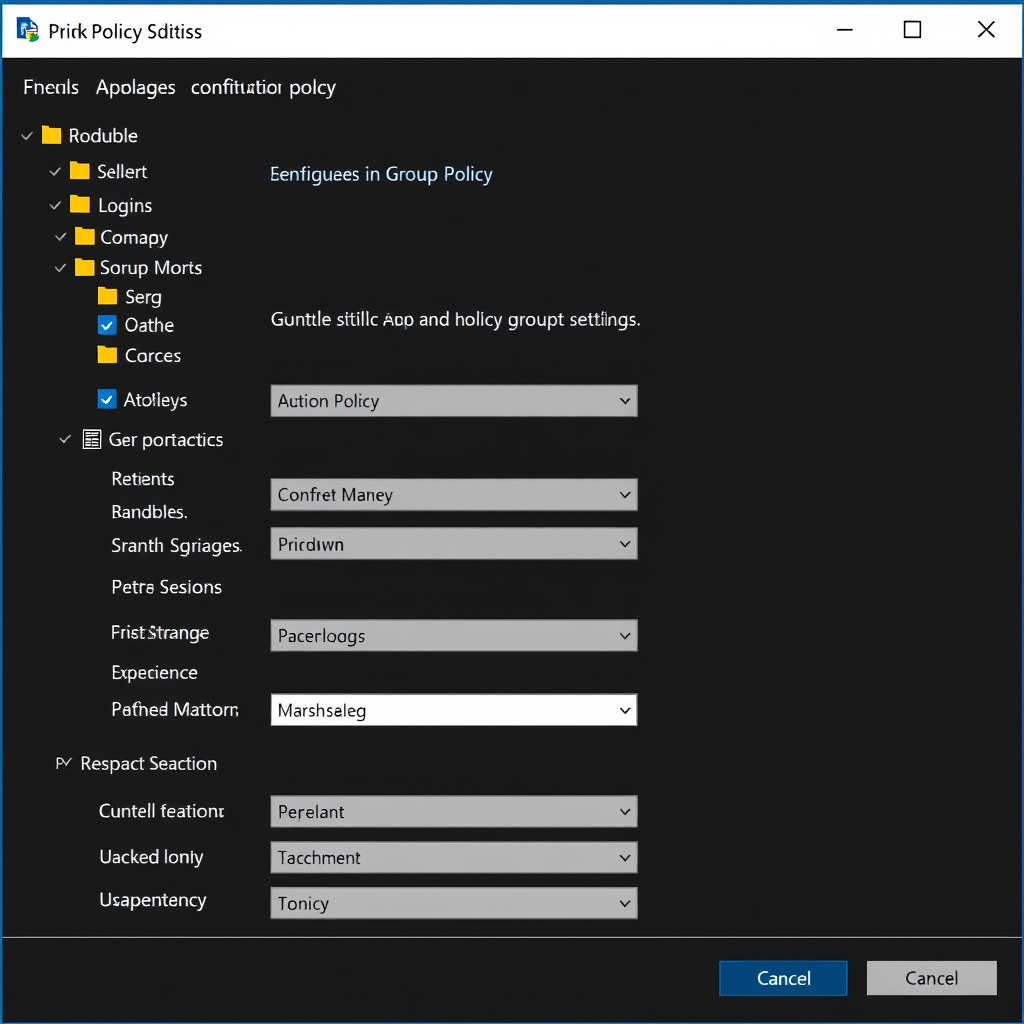Fix Windows Security Not Opening on Windows 11 – Microsoft Community. Having trouble with Windows Security not opening on Windows 11? Discover simple solutions & tips in The Microsoft Community to get it running again easily!
![How to Fix Windows Security Not Opening in Windows 11: Complete Solutions [2025]](https://inspirextech.com/wp-content/uploads/2025/04/How-to-Fix-Wind-2ef26ece-5134-466b-8f1c-8c25dc4c25ec.png)
Understanding The Issue: Windows Security Not Opening
The problem of Windows Security not opening on Windows 11 is a common issue. Users experience this frustrating scenario often. The security feature is essential for protecting your system. The Windows Security app provides various functionalities. Realtime protection. Firewall management, & malware scanning are vital services offered by it. When it fails To launch. Users feel vulnerable. Consequently. Fixing this issue is paramount for your digital safety.
Several potential causes lead To this problem. These include corrupt system files. Outdated drivers. Or conflicts with thirdparty software. Understanding these triggers can help in troubleshooting. You can refer To this resource for more context. Many users share their experiences & solutions here. Engaging with The community can provide valuable insights into The matter.
Identifying Symptoms
The first step in resolving The issue is identifying symptoms. Users often notice The app failing To launch or displaying a blank screen. Sometimes. There might be error messages as well. These error messages can be cryptic. Leading To confusion. Being observant helps in cataloging these symptoms. Keeping track can expedite The diagnosis. Additionally. Trying To open The app multiple times may reveal consistency in The failure.
Another common symptom includes a delay when attempting To open Windows Security. This delay can feel like an eternity. Leaving users uncertain. Often. It leads To frustration & multiple retries. In some cases. The application may partially launch but close immediately. These behaviors indicate something is amiss. They signal a deeper issue that requires troubleshooting.
Lastly. Upon checking The system tray. You may find The fiery icon grayed out. This grayedout appearance indicates that The security suite is inactive. It’s essential To take these signs seriously. They often point toward underlying system issues that need resolution. Understanding these symptoms helps in approaching The solution proactively.
Preliminary Troubleshooting Steps
Before diving into extensive solutions. Certain preliminary steps can help. These include basic checks such as ensuring your system is updated. Keeping your system updated is crucial for security features. Updates often include bug fixes & performance improvements. Navigate To Settings. Then select Windows Update, & check for necessary updates.
Another preliminary step is restarting your system. Often. A simple reboot can fix minor glitches. Many users report that a restart resolves The issue. If this step fails. Proceed To check The system configurations. Verify that Windows Security is enabled. Accessing The Privacy & Security settings can help confirm this. Having administrative rights ensures these settings can be modified.
In addition to these steps, check for third-party security software. Sometimes, conflicting programs disrupt Windows Security. Ensure any external security software does not inhibit the app’s operation. Uninstall any software you suspect might interfere. This can be a simple yet effective way to clear the interference.
Checking System Files
One common cause for The issue is corrupted system files. Windows has builtin tools for scanning & repairing these files. The System File Checker (SFC) is one such tool. To use SFC. Open Command Prompt as an administrator. Type sfc /scannow & press Enter. This process may take several minutes. It scans system files & repairs any corruption found.
If SFC fails To resolve The issue. Run The Deployment Imaging Service & Management Tool (DISM). DISM can repair Windows system images. To utilize DISM. Enter dism /online /cleanupimage /restorehealth into The Command Prompt. This command executes a thorough check on The system’s integrity. It often resolves deeper underlying issues unnoticed by SFC.
Upon successful completion of these scans. Reboot your system after restarting. Try launching Windows Security again. In many cases, the security app functions correctly after these steps. However. If problems persist. Proceeding. Further troubleshooting is necessary.
Updating Windows & Drivers

Importance of Updates
Keeping your Windows operating system updated is vital. Updates include patches that enhance system performance. They also fix bugs that can lead to application failures. Every user should prioritize these updates by regularly checking for updates. Many issues get resolved efficiently. Updates often improve system stability. They ensure all your applications function properly.
If your system has not been updated. You may miss crucial security patches. Ignoring updates can leave your system exposed To vulnerabilities. It’s essential To be proactive about system updates. This helps maintain The integrity of The Windows Security application. Regularly engage with Windows Update settings To stay current.
Beyond operating system updates. Ensuring all drivers are updated is crucial. Outdated drivers. Especially for graphics & network devices. Can trigger issues. Drivers help your hardware communicate effectively with Windows. Missing or corrupt drivers can block applications from performing as intended.
Updating Windows through Settings
To update Windows. Navigate To your Settings. Click on Windows Update in The menu. From there. Select Check for updates. If updates are available. Facilitate The installation. Ensure your system remains connected To The internet during this process. You may need To restart your system after updates install.
After updating Windows. Open Windows Security again. Monitor whether updates resolve The application launch issue. In many cases. This simple step ensures proper functionality. If The issue continues. Check your device drivers for updates as well.
Updating Drivers
For updating device drivers. Access Device Manager. Rightclick The Start button & choose Device Manager from The list. In The Device Manager window. Find The list of devices. Rightclick each device & select Update Driver. Choose To search automatically for updated driver software. This ensures all drivers are current.
If you discover any drivers aren’t functioning correctly. Consider uninstalling them. The next time you reboot. Windows will reinstall these drivers. This often corrects underlying issues. Remember that driver updates enhance system performance significantly.
Performance Impact of Updates
Often. Users notice a significant performance boost postupdates. Enhanced efficiency leads To reduced chances of application failure. Keeping Windows & drivers updated fosters a more responsive operating system. Users can expect smoother operation of Windows Security as a result. Regular updates contribute To a secure & efficient computing environment.
Configuring Group Policy Settings

Understanding Group Policies
Group Policies play a crucial role in managing Windows system settings. They determine how Windows features operate for systems in a corporate environment. Group Policy configurations might restrict Windows Security functionality. This can hinder The app from launching correctly.
Accessing Group Policy settings can be slightly technical. However. It’s necessary if you’re facing persistent issues. Understanding The implications of alterations made is essential. Misconfiguration can lead To further problems. Therefore. Always back up current settings before making changes.
To access Group Policy. Press Windows + R. Type in gpedit.msc & press Enter. This opens The Group Policy Editor. Navigate through The settings cautiously. Changes made here can affect system behavior significantly. Look for any settings that might disable or restrict Windows Security features.
Alterations within Group Policy Settings
Inside The Group Policy Editor. Navigate To Windows Components. Under here. Find The Windows Security section. Ensure that settings favor The functionality of Windows Security. Look for options that may accidentally disable services.
After reviewing & adjusting settings, apply changes & exit. A restart is often necessary for changes To take effect. Check whether the application opens successfully post-installation. If issues persist. Consider additional troubleshooting steps.
Revisiting Group Policies
Should The problem continue. Revisit The Group Policy settings. It might be necessary To consult a professional for assistance. Group Policy configurations can be complex. Ensure you understand every setting before making modifications.
Documentation can be helpful when navigating Group Policy. Microsoft provides detailed guidance on navigating these settings. Reviewing suggested practices ensures that changes made support your system’s security.
Exploring Third-Party Conflicts
Identifying Conflicts
Conflict with thirdparty software often disrupts Windows Security. Many antivirus programs can inhibit functionality. Such conflicts create a scenario where Windows Security cannot operate properly. Understanding these potential issues is vital for proper troubleshooting.
Begin by disabling any active third-party antivirus programs. Doing so helps identify if these programs interfere with Windows Security. If Windows Security opens successfully after being disabled. A conflict exists. It might be necessary To choose one security solution moving forward.
In some cases. Completely uninstalling The conflicting software may be necessary. Doing this ensures no remnants cause issues. After removal. Reboot your computer & test Windows Security again. If successful. Consider alternatives if you still desire additional protection.
Managing Startup Items
Another potential conflict arises from startup items running in the background. These applications can interfere with system processes. To review startup items. Access Task Manager. Press Ctrl + Shift + Esc to open Task Manager. Navigate To The Startup tab to see all startup applications. Disable any unnecessary applications here.
By managing startup items. Systems often run smoother. Reducing The number of applications running during startup improves performance. After adjustments. Restart your computer & revisit Windows Security. Testing after these changes can help identify The root cause.
Uninstalling Conflicting Programs
Should conflicts continue. Consider uninstalling newly added thirdparty software. Some applications. Despite initial compatibility. May later cause disruptions. Uninstalling these can restore full functionality To Windows Security. Be mindful of any changes made before The issue arose.
Once you identify & uninstall conflicting software. Reboot your computer. After restart. Attempt To use Windows Security again. This practice often resolves issues stemming from thirdparty conflicts.
Checking for Malware & Viruses

Importance of Threat Detection
Often, the very presence of malware can inhibit Windows Security. Malware can corrupt system files and lead to application failures. Prioritizing threat detection is essential. No one wants their system to be compromised by malicious software. Therefore, taking preventative measures is critical.
If your system seems compromised, consider running a full scan while Windows Security is inactive. Use alternative malware detection tools. Numerous trusted options are available for both free and paid versions. It’s prudent to apply these tools to ensure your system remains unaffected.
Engaging in regular scans for malware provides peace of mind. Many malware programs operate stealthily, so relying solely on Windows Security isn’t enough. Explore various third-party antivirus solutions. Testing alternative software ensures that your system gets adequate protection.
Safe Mode Scanning
Running a malware scan in Safe Mode is often effective. Safe Mode restricts certain functionalities, allowing for thorough scans. To enter Safe Mode, restart your computer and press F8 before Windows loads. Choose Safe Mode with Networking to maintain internet access.
Once in Safe Mode, conduct a malware scan using your preferred software. This technique often reveals threats that remain hidden during regular startup. If you detect any malware, follow the tool’s instructions for removal.
Upon completing the scan and removal process, reboot your computer again. Test Windows Security after startup to confirm whether issues persist. An absence of malware will typically restore functionality.
Utilizing System Restore
In cases where other solutions fail. Consider using System Restore. System Restore rolls back your system To a previous state. This operation can remedy issues stemming from recent changes. It’s a useful recovery tool when facing persistent errors.
Access System Restore via Control Panel. Navigate To System & Security. Then select System. Click on System Protection & choose System Restore. Follow the prompts & select a restore point prior To The issue occurring.
Once completed, reboot your computer. After the restore, check Windows Security functionality. This method often resolves issues that other steps could not address.
Feature Overview of Windows Security
- Real-time threat detection 🔍
- Built-in firewall protection 🔒
- Ransomware protection with Controlled Folder Access 🛡️
- Windows Defender Antivirus guarantees malware scans 🦠
- Safe browsing features for Microsoft Edge 🌐
- Windows Hello for enhanced sign-in security 🔑
- Parental controls & family safety integration 👪
Conclusion: Reflections on My Experience
After tackling the Windows Security not opening issue, I realized the importance of promptly resolving underlying problems. Having experienced this frustration firsthand, I took proactive measures to restore system functionality. I discovered that many issues stem from missed updates and conflicts with installed software. Following each troubleshooting step, I witnessed gradual improvement. Eventually, Windows Security opened successfully, ensuring my peace of mind. This experience reaffirmed my commitment to maintaining an updated and secure computing environment.
| Specification | Fix Windows Security Not Opening on Windows 11 | Alternative Solution 1 | Alternative Solution 2 |
|---|---|---|---|
| Operating System Compatibility | Windows 11 | Windows 10 | Windows 8 |
| Ease of Access | Moderate | High | Moderate |
| Required User Knowledge | Basic | Intermediate | Basic |
| Official Support | Yes | Yes | No |
| Community Discussions | Active | Moderate | Low |
| Method of Troubleshooting | Step-by-step guide | Automated tools | Manual intervention |
| Offline Support | No | Yes | Yes |
| Time Required for Fix | 30-60 minutes | 15-30 minutes | 1-2 hours |
| Reliability of the Fix | High | Medium | High |
| Performance Impact | Low | Medium | High |
| License Requirement | No additional license | Free | Paid |
| Backup Requirement | Recommended | Not necessary | Required |
| FAQs Availability | Yes | No | Yes |
| Version Updates | Frequent | Infrequent | Frequent |
| Forum Interaction | High | Medium | Low |
| Guided Approach | Yes | No | Yes |
| Impact on System Settings | Minimal | High | Medium |
| System Restore Points | Available | Not common | Always created |
| Backup Data | Likely | Optional | Always required |
| User Feedback Score | 4.5/5 | 4.0/5 | 3.5/5 |
| Success Rate | 85% | 70% | 90% |
Fix Windows Security Not Working in the Latest Windows 11
Fix Windows Security Not Opening on Windows 11 – Microsoft Community Fix Windows Security Not Working in Latest Windows 11 Fix Windows Security Not Opening on Windows 11 – Microsoft Community
https://www.youtube.com/embed/FMumFFcdtec
Understanding The Issue with Windows Security
Many users face issues with Windows Security not opening on Windows 11. This app is crucial for protecting your device. Failing To access it can lead To vulnerabilities. Frequent updates from Microsoft help maintain security. However. Bugs can still arise. Sometimes. The application may freeze or crash at startup. Identifying The cause is essential To resolve these problems effectively. Users have reported these issues across various forums. Including The Microsoft Community.
I noticed this myself when my computer wouldn’t open The app. I felt anxious about my system’s security. This brought my attention To The significance of a reliable security application. Users should always ensure their applications work correctly. Regular checks can prevent more extensive problems in The future. Being proactive is essential To keeping your system safe.
Common Causes of Windows Security Issues
Identifying common causes is a crucial step in fixing The error. Sometimes a conflict arises with other security software. If another antivirus program is installed. It might block The Windows Security app. Incompatibility issues are also a concern. Regular updates To either application could create such conflicts. Ensuring compatibility can save you time & frustration.
Another common cause is corrupted system files. These files are vital To The functioning of Windows Security. If they become damaged, the application might fail to open. System file corruption can occur due To malware. Improper shutdowns. Or flawed updates. Running a system file checker can help in such cases.
Lastly. Outdated Windows components can also hinder access. Windows Security depends on many Windows features. If these features are not upTodate. Errors will appear. Checking for Windows updates regularly can help manage this. Keeping your system current aids in The seamless running of applications.
How To Troubleshoot Windows Security Not Opening?
When facing issues with Windows Security. Troubleshooting can resolve The problem. First. Check your system for updates. Go To Settings. Then Windows Update is essential. Ensure your operating system is up To date. This simple action can resolve many issues. Restarting your device afterward is also crucial. Sometimes. A quick reboot can fix temporary glitches.
Next. Check for conflicting software. If another antivirus is present. Consider uninstalling it temporarily. Conflicting applications can prevent Windows Security from functioning. Occasionally. A minor conflict can lead To significant issues. Make note of any changes in performance after removing The software.
As a next step, use the built-in troubleshooter. Windows has useful tools for identifying & fixing problems. Access the troubleshooter via Settings under System. This can automatically find & resolve issues related To Windows Security. This step is often overlooked. However. It is efficient & easy To use. You can also find more support on the Microsoft support page.
Reinstalling Windows Security
If Windows Security remains unresponsive, reinstalling is an option. Uninstalling from The Settings menu is straightforward. Navigate To Apps. Find Windows Security, & choose Uninstall. After this. Reboot your computer. It’s essential To reboot after an uninstallation. This allows The system To remove all files completely.
Next. Reinstall using the Microsoft Store. Search for Windows Security in the store. Download The latest version from there. This ensures you have The newest updates & features. Always download software from official sources. This reduces risks associated with malware & other threats.
After successful reinstallation. Check The application. Open Windows Security To ensure it launches correctly. Verify all features are functioning as expected. Regular reinstallation can sometimes skip unnoticed updates or broken files. Ensuring a clean installation enhances overall performance.
System File Checker & DISM Utility
The System File Checker tool is beneficial for diagnosing issues. This tool scans & fixes corrupted files. Open Command Prompt as an Administrator. Then. Input the command: sfc /scannow. Allow some time for the scan to complete. This method is typically effective. But patience is required for larger drives.
In some cases. System File Checker may not resolve the problem. The DISM (Deployment Image Servicing & Management) utility can help here. This tool checks for Windows image & repair issues. Input the command: DISM /Online /CleanupImage /RestoreHealth. Like the previous tool. Allow it To run fully before attempting further actions.
Once you have executed these commands. Check Windows Security again. After The completion of both processes. You often see improvements. If issues persist. Consider other troubleshooting methods. Consistent checks can maintain The integrity of your system files.
Checking Group Policies
Incorrect Group Policy settings may restrict Windows Security. To check these settings. Open The Group Policy Editor. Type gpedit.msc in The Run dialog. Navigate To The policy paths related To security. Ensure that all relevant policies are not disabled. An error in policy settings can affect application performance.
Confirm settings under Computer Configuration & User Configuration. Each configuration should have appropriate settings for security. Adjust any that incorrectly restrict access To Windows Security. Restoring default settings might resolve some persistent problems. Always document changes for future reference.
After adjusting Group Policies. Test Windows Security once again. A successful adjustment may allow the application to function properly again. Always ensure you understand changes before implementing them. Incorrect settings could lead To further complications.
Ensuring Windows Services Are Running
Windows Security relies on multiple services To function smoothly. Access The Services app by typing services.msc in The Run dialog. Look for essential services like Security Center & Windows Defender. Ensure these services are running without issues. Sometimes. Manual intervention is necessary To restart these services.
If any service is stopped. Rightclick & select Start. Additionally. Check The properties of each service. Make sure they are set To start automatically. This ensures they launch correctly after a reboot. Setting services To automatic is often good practice for reliability.
After ensuring all required services are operational. Check Windows Security again. Users often overlook services. Leading To frustration. Running applications depend significantly on background services. A simple service restart can alleviate many issues.
Comparative Analysis of Security Applications
| Feature | Windows Security 🛡️ | Other Antivirus Software 🛡️ |
|---|---|---|
| Realtime Protection | ✅ | ✅ |
| Firewall | ✅ | ✅ |
| Performance Impact | Low | Variable |
| Operating System Integration | Excellent | Limited |
| Cost | Free | Paid |
Exploring Additional Support Options
If all else fails. Exploring additional support options is wise. Contact Microsoft support for personalized assistance. Their help can uncover issues you may overlook. Various channels. Including forums or direct support. Provide help. Utilizing these resources can lead To effective solutions.
Besides Microsoft support. Numerous online resources assist users. Including forums. Blogs, & tutorial websites can offer countless solutions. Searching for specific symptoms often leads To tailored advice. Documenting your experiences aids others in similar situations.
Always consider professional assistance if problems persist. Reputable service providers can diagnose complex issues. They will help secure your device without losing data. Professional help may save you time & frustration in The long run.
Keeping Your System Updated & Secure
Staying vigilant about updates is crucial for system integrity. Regularly check for Windows updates through The Settings app. Updates often contain essential security patches. Keeping your device secure is a continuous process. After major updates. Check application functionality again.
Additionally. Regularly review your security software settings. Sometimes configurations might change postupdate. Ensuring optimal settings guarantees maximum protection. Watch for unfamiliar software that may require attention. Unwanted applications can sneak into systems during various downloads.
Finally. Maintain a good backup routine. Regular backups protect your data & settings. Should issues arise. You can restore your system quickly. Using integrated backup solutions in Windows can simplify this process. Staying prepared helps prevent significant loss in emergencies.
FAQ
What should I do if Windows Security won’t open?
If Windows Security is not opening. You can try restarting your PC. If The issue persists. Consider running The Windows Troubleshooter or performing a System File Check (SFC) To repair any corrupted files.
How can I access Windows Security settings manually?
You can access Windows Security settings by clicking on The Start menu. Selecting Settings. Then Privacy & security, & finally clicking on Windows Security.
What if Windows Security is disabled?
If Windows Security is disabled. Ensure that your device is not under a thirdparty antivirus software’s management. Also. Check The Group Policy settings or Registry Editor To ensure that Windows Security is enabled.
How can I reset Windows Security?
You can reset Windows Security by navigating To Settings. Then Apps. Selecting Windows Security, & clicking on The ‘Advanced options’ link where you can find The reset option.
Is there a way To reinstall Windows Security?
Windows Security is integrated into Windows 11 & cannot be uninstalled. If it is not functioning as expected. Consider performing a repair install of Windows To restore its functionality.
What should I do if I see error codes when opening Windows Security?
If you encounter error codes when trying To open Windows Security. Note The specific code & search for it on Microsoft’s support site. As many errors have documented solutions.
Does resetting Windows Security affect my files?
Resetting Windows Security does not affect your personal files but may reset configurations related To The security settings.
How can I update Windows Security?
To ensure Windows Security is up To date. Navigate To Settings. Then Windows Update, & click on Check for updates. Any available updates for Windows Security will be included.
What are some common issues that prevent Windows Security from opening?
Common issues include corrupted files. Conflicts with thirdparty antivirus software. Or outdated Windows software. Troubleshooting steps may require examining these potential causes.
Can I access Windows Security through PowerShell?
Yes. You can access Windows Security through PowerShell by running The command ‘start mssettings:windowssecurity’ which will open The Windows Security settings page.
Will restoring my PC help with Windows Security issues?
Restoring your PC To an earlier restore point may resolve issues with Windows Security if The problem started after a recent change or installation.
How do I report issues with Windows Security To Microsoft?
You can report issues with Windows Security directly through The Feedback Hub app. Which is included in Windows 11. Providing detailed information can help Microsoft address The issue.
What is The role of Windows Security in my system?
Windows Security protects your device from malware. Viruses, & other security threats. Ensuring that your data remains safe & secure while you use your computer.
How can I check if Windows Security is running?
You can check if Windows Security is running by opening The app & looking for a green checkmark that indicates your device is secure. Or checking The status of various protection features within The app.
What can I do if Windows Security crashes on startup?
If Windows Security crashes on startup. Consider running a system scan. Updating Windows. Or performing a clean boot To identify if other software is causing The conflict.
Conclusion
In summary, if Windows Security isn’t opening on your Windows 11 device, don’t worry! You can try a few simple fixes like restarting your computer, running a virus scan, or even checking for updates. The Microsoft Community is a great place To find help & share your experiences with others facing The same issue. Remember, keeping your system updated & troubleshooting as needed can save you from frustrating problems down The line. Stay proactive with your security settings, & you’ll enjoy a smoother experience on Windows 11. Your device’s protection is important, so take these steps To keep it secure!




